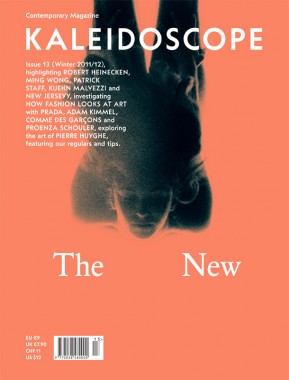
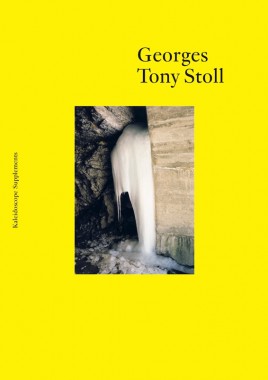
Kaleidoscope Magazine 13, The New
Softcover, 262 pp., offset 4/4, 220 x 287 mm
Softcover, 48 pp., offset 4/4, 190 x 270 mm [Georges Tony Stoll supplement]
ISSN 2038-4807
ISBN 978-88-97185-18-5
Published by Kaleidoscope Press
$12.00 ·
At the core of a platform that includes an exhibition space and an independent publishing house, Kaleidoscope is an international quarterly of contemporary art and culture founded in 2009 in Milan. Distributed worldwide on a seasonal basis, it has gained widespread recognition as a trusted and timely guide to the present (but also to the past and possible futures), unique in its interdisciplinary and unconventional approach.
For the Winter 2011/12, editor-in-chief Alessio Ascari is proud to present the first issue of Kaleidoscope magazine under the art direction of the prominent London-based design studio OK-RM — Oliver Knight and Rory McGrath.
HIGHLIGHTS
Robert Heinecken by Kavior Moon; Ming Wong by Hu Fang; Kuehn Malvezzi by Hila Peleg; New Jerseyy by Quinn Latimer; Patrick Staff by Catherine Wood.
MAIN THEME — How Does Fashion Look at Art?
Adam Kimmell by Angelo Flaccavento; Commes des Garçons by Maria Luisa Frisa; Proenza Schouler by Michele D’Aurizio.
MONO — Pierre Huyghe
Essay by Éric Troncy; Interview by Barbara Casavecchia; Special Project: Study for Zoodram; Focus by Chris Wiley.
REGULARS
Pioneers: Bruce McLean by Simone Menegoi; Futura: Ed Atkins by Hans Ulrich Obrist; Panorama: Toronto by Amil Niazi; Souvenir d’Italie: Luigi Ghirri by Luca Cerizza; Producers: Ute Meta Bauer by Carson Chan.
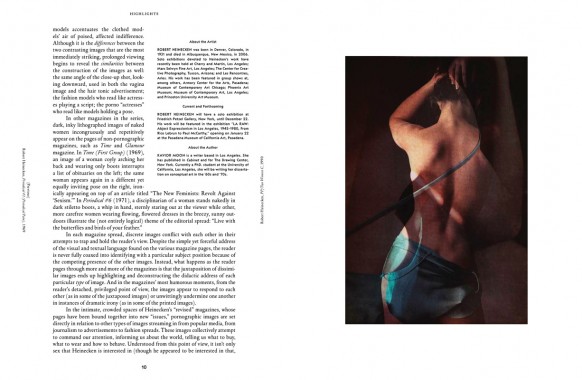
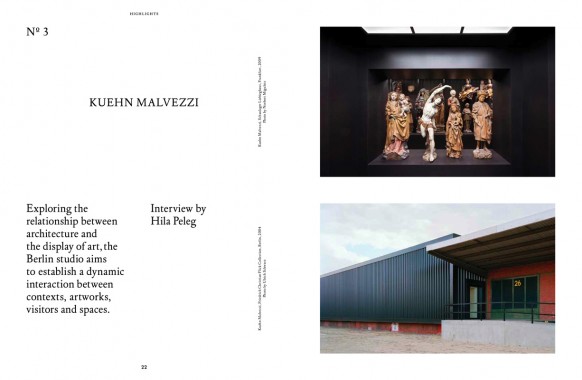
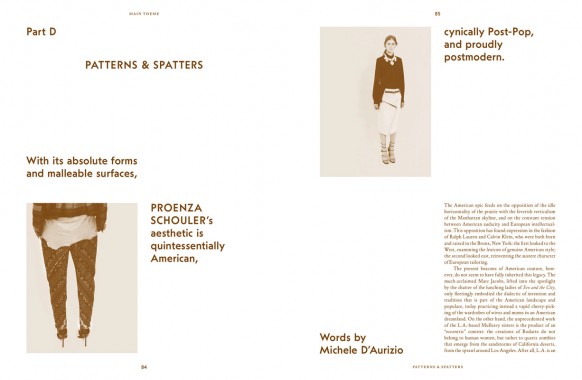
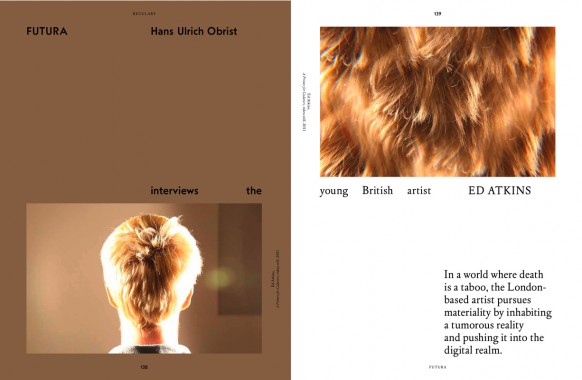
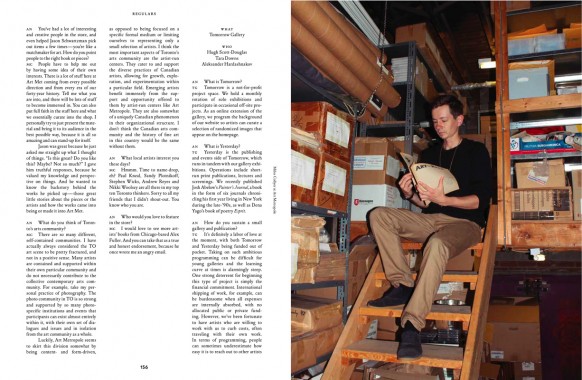
Adam Kimmell, Alessio Ascari, Aliina Astrova, Amil Niazi, Angelo Flaccavento, Art, Barbara Casavecchia, Bruce McLean, Carson Chan, Catherine Wood, Chris Wiley, Commes des Garçons, Cristina Travaglini, Culture, Distribution, Ed Atkins, Éric Troncy, Francesco Vezzoli, Georges Tony Stoll, Hans Ulrich Obrist, Hila Peleg, Hu Fang, Joanna Fiduccia, Kaleidoscope Press, Kavior Moon, Klingspor, Kuehn Malvezzi, Laurenz Brunner, Luca Cerizza, Luigi Ghirri, Maria Luisa Frisa, Michele D'Aurizio, Ming Wong, Nicholas Cullinan, OK-RM, Oliver Knight, Patrick Staff, Photography, Pierre Huyghe, Proenza Schouler, Quinn Latimer, Robert Heinecken, Rory McGrath, Simone Menegoi, Ute Meta Bauer
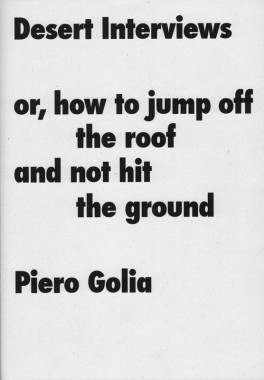
Piero Golia, Desert Interviews or, how to jump off the roof and not hit the ground
Softcover, 100 pp., offset 4/1, 148 x 210 mm
Edition of 2000
ISBN 978-3-03764-106-4
Published by JRP|Ringier
$28.00 ·
Piero Golia founded in 2005, with his long-time friend Eric Wesley, the Mountain School of Arts, an educational structure that rapidly became a new spot on the cultural map of the city of Los Angeles.
This book, composed of discussions between artists, presents a kind of report on this unique “institution:” teaching methods, academic syllabus, and students’ selection are here explained with metaphors, compared with artistic interaction, and equaled to performances. Not unlike Golia’s work itself, the development of the school and its program follow a poetic of the gesture, of the instant, and of actions recalling Fluxus, Gino de Dominicis’ or Paul McCarthy’s works.
As a career’s start, Piero Golia successfully convinced a woman to have his portrait and the words “Piero My Idol” tattooed on her back (tattoo, 2001); soon after, following an invitation to the Tirana Biennale, he rowed across the Adriatic Sea in the opposite direction to migratory movement to reach Albania (”Going to Tirana,” 2000). And, on January 14, 2005, Golia vanished from New York City leaving no documented proof of his whereabouts; he traveled from a place to another, crossing borders without a trace, for resurfacing only on the morning of February 7 at the Royal Academy of Arts in Copenhagen for a unique lecture about his adventurous trip. He now lives in Los Angeles, a place that blurs the boundaries between reality and fiction, making it the perfect setting for his exploration into the process of myth-making and his ironic outlook on contemporary society.
Andrew Berardini, Art, DAP, Education, Emilie Renard, Eric Wesley, Fluxus, Gino de Dominicis, John Armleder, JRP|Ringier, Lisa Mark, Los Angeles, Mountain School of Arts, Paul McCarthy, Piero Golia, Pierre Huyghe, Richard Jackson, Royal Academy of Arts in Copenhagen, Tirana Biennale
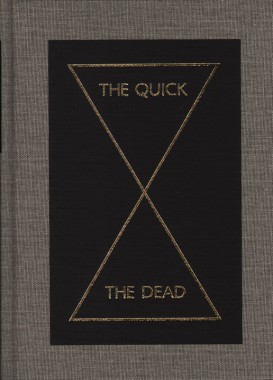
Peter Eleey, The Quick and the Dead
Hardcover, 352 pp., offset 4/1, 6.75 x 9 inches
Edition of 2000
ISBN 9780935640939
Published by Walker Art Center
$45.00 ·
Artists have always used their imaginations to see beyond visible matter — to posit other physics, other energies, new ways of conceiving the visible and new models for art — but the past century has seen an explosion of such investigations. In the fashion of a Wunderkammer, The Quick and the Dead takes stock of the 1960s and 70s legacy of experimental, or “research” art by pioneers like George Brecht, who posited objects as motionless events and asked us to consider “an art verging on the non-existent, dissolving into other dimensions,” and Lygia Clark, whose foldable sculptures sought to dissolve the boundary between inside and outside, each “a static moment within the cosmological dynamics from which we came and to which we are going.” In a series of encounters with art made strange by its expansions, contractions, inversions and implosions in time and space, The Quick and the Dead surveys more than 80 works by a global, multigenerational group of 50 artists, scientists and musicians — among them James Lee Byars, Joseph Beuys, Marcel Duchamp, Harold Edgerton, Ceal Floyer, Felix Gonzalez-Torres, Pierre Huyghe, The Institute for Figuring, Paul Ramirez Jonas, Stephen Kaltenbach, On Kawara, Christine Kozlov, David Lamelas, Louise Lawler, Paul Etienne Lincoln, Mark Manders, Kris Martin, Steve McQueen, Helen Mirra, Catherine Murphy, Bruce Nauman, Rivane Neuenschwander, Claes Oldenburg, Roman Ondák, Adrian Piper, Roman Signer and Shomei Tomatsu, among many others. Includes reprints of texts by diverse luminaries such as John McPhee, Jalal Toufic, Oliver Sacks, Allan Kaprow and Robert Smithson.
Adrian Piper, Art, Bruce Nauman, Catherine Murphy, Ceal Floyer, Christine Kozlov, Claes Oldenburg, DAP, David Lamelas, Felix Gonzalez-Torres, Harold Edgerton, Helen Mirra, James Lee Byars, Joseph Beuys, Kris Martin, Louise Lawler, Marcel Duchamp, Mark Manders, On Kawara, Paul Etienne Lincoln, Paul Ramirez Jonas, Peter Eleey, Pierre Huyghe, Rivane Neuenschwander, Roman Ondák, Roman Signer, Shomei Tomatsu, Stephen Kaltenbach, Steve McQueen, The Institute for Figuring, Walker Art Center








